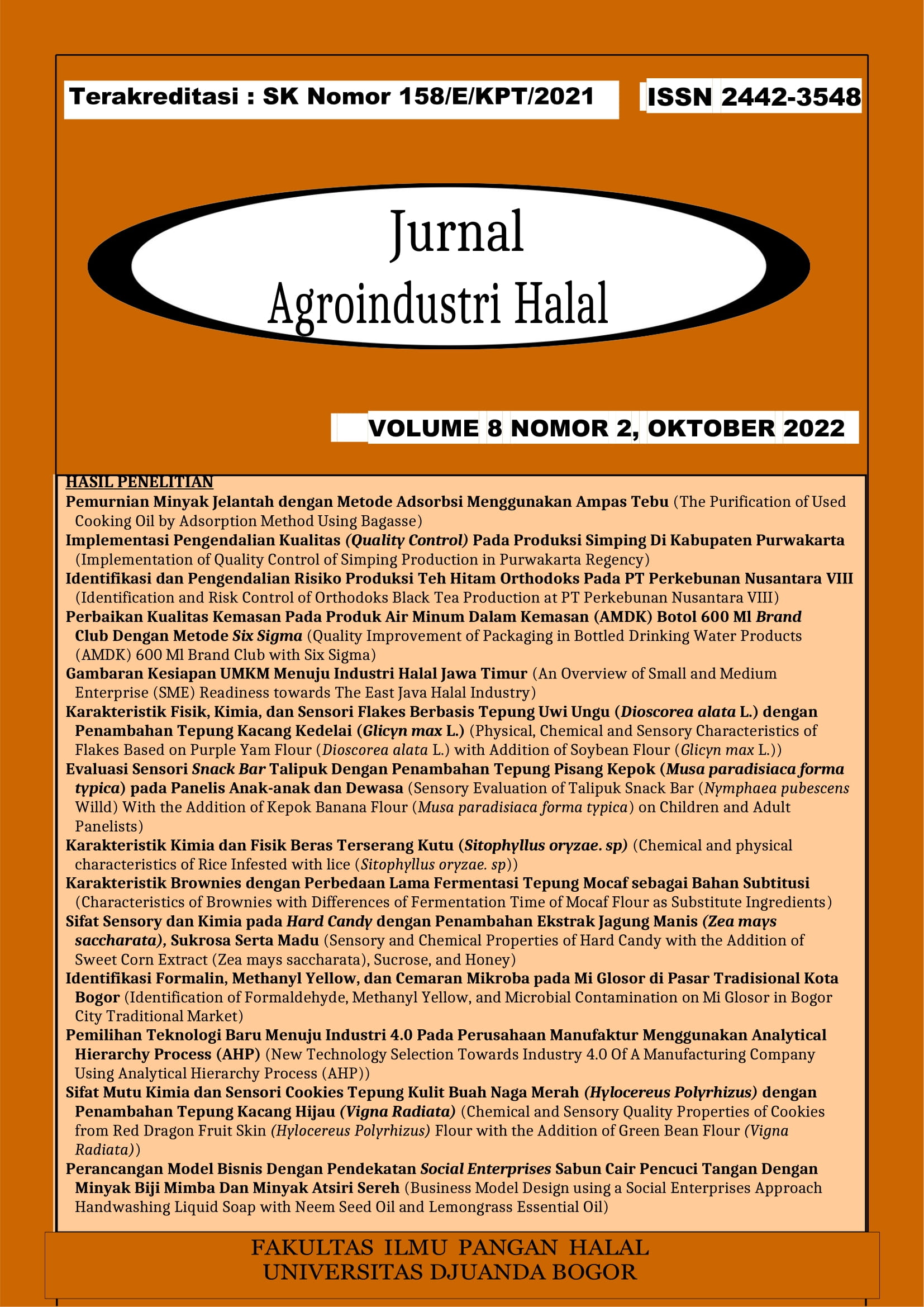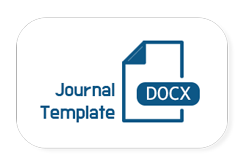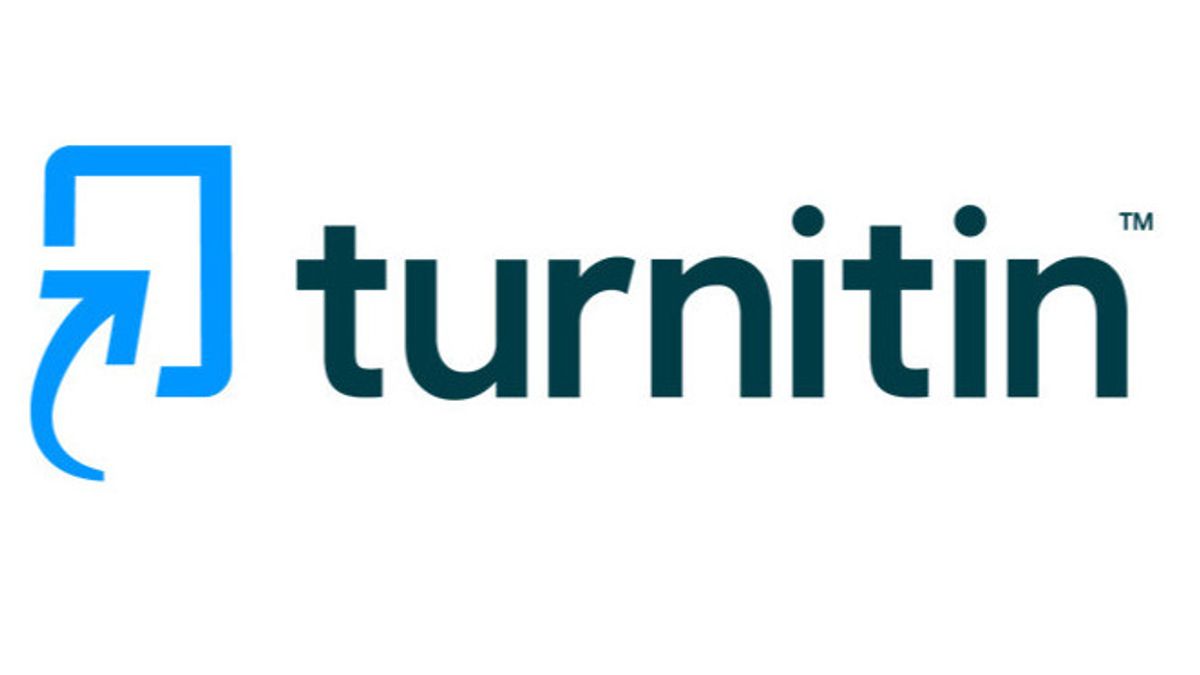Karakteristik Brownies dengan Perbedaan Lama Fermentasi Tepung Mocaf sebagai Bahan Subtitusi
Characteristics of Brownies with Differences of Fermentation Time of Mocaf Flour as Substitute Ingredients
DOI:
https://doi.org/10.30997/jah.v8i2.6751Keywords:
Keywords: Brownies, Mocaf, Cassava, FermentationAbstract
The purpose of this study was to examine the effect of the content of mocaf flour with different fermentation times on the quality of brownies. This study used a completely randomized design method. The samples used were mocaf flour brownies which were then handed over to the panelists, each panelist getting 4 samples of mocaf flour brownies. Sample codes to be given are A (24), B (48), C (72), and D (96). Analysis of mocaf flour brownies, namely water content and protein content. The results of the organoleptic test showed that sample D was the most preferred brownie with a percentage of 6.40 (Aroma), 6.90 (Taste), 6.87 (Texture). The results of the water content test are that the water content in sample A is 10.87%, sample B is 10.67%, sample C is 10.32% and sample D is 9.63%. The difference in fermentation time affects the protein content of mocaf flour. It can be seen from the test results obtained that sample A is 0.19%, sample B is 0.35%, sample C is 0.19% and sample D is 0.12%. It can be seen from the results of the brownie protein content test that the sample A obtained was 2.31%, sample B was 2.78%, sample C was 3.63% and sample D was 4.32%. It can be concluded that there is an effect of mocaf fermentation time on the moisture content and protein content of brownies.
References
Aida, N, Kurniati LI, dan Gunawan. (2012). Pembuatan Mocaf dengan proses fermnetasi menggunakan Rizhopus orizae dan Saccharomyces serevicaae. Prosiding Semnas Teknik Kimia Soebardjo Brotohrjdono. Surabaya, 21 Juni 2012.
Arsyad, M. (2016). Pengaruh penambahan tepung mocaf terhadap kualitas biskuit. Jurnal Agropolitan, 3(3).
Badan Pusat Statistik Kalbar. (2019). Data Penghasil Tanaman Singkong. Kabupaten Sambas.
Badan Pusat Statistik. (2011). Konsumsi Tepung Terigu. Biro Pusat Statistik.
Cipto D, Efendi R, Rosii E. (2016). Pemanfaatan tepung tempe dengan penambahan bubuk kayu manis dalam pembuatan kukis dari sukun. JOM Faperta, 3(2).
Downey. (1992). Manajemen Agribisnis. Penerbit Erlangga
Darmawan, M. R, Andreas, P., Bakti Jos, & Sumardiono, S. (2013). Modifikasi ubikayu dengan proses fermentasi menggunakan starter Lactobacillus casei untuk produk pangan. Jurnal Teknologi Kimia Industri, 2(4), 137-14. https://ejournal3.undip.ac.id/index.php/jtki/article/view/4037
Hanafiah, K. A. (2016). Rancangan Percobaan: Teori dan Aplikasi. Rajawali Pers.
Hidayat, B., Kalsum1, N., & Surfiana. (2009). Karakterisasi tepung ubi kayu modifikasi yang diproses menggunakan metode pragelatinisasi parsial. Jurnal Teknologi Industri dan Hasil Pertanian, 14(2). http://dx.doi.org/10.23960/jtihp.v14i2.148%20-%20159
Hersoelistyorini, W., Dewi, S. S., & Kumoro, A. C. (2015). Sifat fisikokimia dan organoleptik tepung mocaf (modified cassava flour) dengan fermentasi menggunakan ekstrak kubis. https://jurnal.unimus.ac.id/index.php/psn12012010/article/view/1476
Nusa, M. I., Suarti, B., &Alfiah. (2012). Pembuatan tepung mocaf melalui penambahan starter dan lama fermentasi (Modified Cassava Flour). Jurnal Ilmu Pertanian, 17(3). http://dx.doi.org/10.30596%2Fagrium.v17i3.322
Oktadiana, H., Abdullah, M., Renaldi, K., & Dyah. N. (2017). Diagnosis dan tata laksana penyakit Celiac, J. Penyakit Dalam Indonesia, 4(3), 165. http://dx.doi.org/10.7454/jpdi.v4i3.131
Ruriani, E., Nafi, A., Yulianti, L. D., & Subagio, S. (2013). Identifikasi potensi mocaf (Modified Cassava Flour) sebagai bahan pensubstitusi teknis terigu pada industri kecil dan menengah di Jawa Timur. PANGAN, 22(3), 229 – 240. https://doi.org/10.33964/jp.v22i3.99
Soekarto, S. T. (2012). Uji Organoleptik Formulasi Cookies Kaya Gizi. Universitas Indonesia.
Sudarmadji, S. B., Haryono, & Suhardi. (1997). Prosedur Analisa untuk Bahan Makanan dan Pertanian. Liberty.
Salim, E. (2011). Mengolah singkong menjadi tepung mocaf. Lily publisher.
Sembiring. H, Hasnul. H, and Diana. D. (2016). Kebijakan Pengembangan Gandum di Indonesia, in Gandum: Peluang Pengembangan di Indonesia. IAARD Press http://balitsereal.litbang.pertanian.go.id/buku-gandum/
Utomo, J. S. (2011). Teknologi pengolahan ubikayu dan ubijalar mendukung ketahanan pangan. Jurnal Teknologi Pertanian, 42-46.
Yanuarti A. R, & Afsari, M. D. (2016). Profil Komoditas Barang Kebutuhan Pokok dan Barang Penting: Komoditas Tepung Terigu. Kementrian Perdagangan RI.
Downloads
Published
How to Cite
Issue
Section
License

This work is licensed under a Creative Commons Attribution-ShareAlike 4.0 International License.
Authors who publish with Jurnal Agroindustri Halal agree to the following terms:
- Authors retain copyright and grant the journal right of first publication with the work simultaneously licensed under a Creative Commons Attribution 4.0 International License that allows others to share the work with an acknowledgement of the work's authorship and initial publication in Jurnal Agroindustri Halal.
- Authors are able to enter into separate, additional contractual arrangements for the non-exclusive distribution of the journal's published version of the work (e.g., post it to an institutional repository or publish it in a book), with an acknowledgement of its initial publication in Jurnal Agroindustri Halal.
- Authors are permitted and encouraged to post their work online (e.g., in institutional repositories or on their website) prior to and during the submission process, as it can lead to productive exchanges, as well as earlier and greater citation of published work








